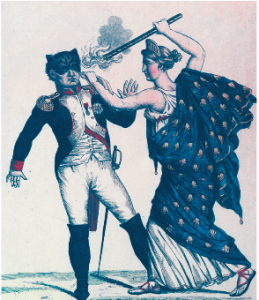
During a lull in fighting at Waterloo in 1815, British solidiers found the bodies of two women. “I saw one of them,” wrote Captain Henry Ross-Lewin of the 32nd Regiment of Foot. “She was dressed in a nankeen jacket and trousers, and had been killed by a ball which had passed through her head.” Other women masquerading as male solidiers would too be discovered. One was Mary Dixon, a 16 year veteran of the infantry battallion who lost her life at Waterloo and was thus discovered to be female. According to scholars (The invisible woman: aspects of women’s work in eighteenth-century Britain), women’s primary motivation for living the life of man and solidier was pecuniary, as it involved such a large variety of work to mask their gender (including dressing their own wounds).
Beyond the famous and many unnamed cross-dressing women solidiers, there were also visible women at the frontlines. Prostitutes frequently set up camp alongside battles or at port, plying their wares to solidiers in need of company.
French women were allowed to accompany troops and often wore partial military dress. British units were limited to six women, usually wives of officers, who could march to the drum alongside their husbands.
There are accounts of wives of solidiers committing great acts of bravery during the battle. The wife of Private McMullen serving in the 27th Foot did her best to carry him off the field when he was wounded in the knee. During this time the battle was in full swing and a musket ball struck her leg and fractured the bone. She later gave birth, adding Waterloo to the family name, and gaining the godfathership of the Duke of York and Albany.
Thomas Deacon of the 73rd of Foot became one of the wounded at Quarte Bras, prompting his very pregnant wife, Martha Deacon, to spend a horrifying night looking for her husband. With three children by her side, she marched twenty miles to Brussels in a torrential down pour desperate to find her husband. She did, and their baby was born soon after.
Wives were required, in many cases according to British Army regulation, to prove themselves not a burden to the troop. They would be required, out of necessity, to administer nursing to wounded men as well as help with other tasks around encampments.
Wives not directly housed with the regiment might elect to stay nearby. British families flocked to Brussels during the Napoleanic Wars and many helped to organize homes as makeshift triage and recovery wards after the battles. Lieutenant George Simmons of the 95th Rifles wrote of the care he received in Brussels after being wounded at Waterloo: “My dear little nurse has never been ten minutes from me since I came to the house,” he wrote. “For ten nights together she never went to bed, but laid her head on my pillow.”
But not all women at Waterloo, or other battle scenes, were so brave nor pious. Women were said to be the worst of looters, scavenging corpses for valuables. Undoubtedly, it was easy for women to go to the battle scene, on the pretext of searching for a lost loved one, and have their pick and pluck of rings, pins, and other spoils. Charlotte Eaton, whose published diary of her time in Brussels during Waterloo wrote, “It was astonishing with what dreadful haste the bodies of the dead had been pillaged. The work of plunder was carried on even during the battle; and those hardened and abandoned wretches who follow the camp, like vultures, to prey upon the corpses of the dead, had the temerity to press forward beneath a heavy fire to rifle the pockets of the officers who fell, of their watches and money. The most daring and atrocious of these marauders were women.”
After the battle of Waterloo, the wives and mothers of solidiers “wandered over this fatal field, wildly calling upon the names of those who were now no more. The very day before we visited it, the widow and the sister of a brave and lamented British officer had been here, harrowing up the souls of the beholders with their wild lamentations, vainly demanding where the remains of him they loved reposed..” Charlotte Eaton wrote.
There are numerous other amazing and fascinating stories about women at Waterloo, and at times of war. Below is a list of some of the top picks to learn more and explore.
For some great romances that feature Brussels and/or Waterloo as a setting, check out
Georgette Heyer:
An Infamous Army
Mary Balogh’s:
Web of Love
Slightly Sinful (I loved this one!)
Slightly Tempted
For more:
http://www.historynet.com/napoleonic-wars-women-at-waterloo.htm
Following the Drum: Women in Wellington’s Warsby Briadier F.C.G. Page 1986 Ebenezer Bylis & Sons Ltd. ISBN 0 233 97960 3











Great post! One of my favorite romances with a Brussels setting is Mary Jo Putney’s “Shattered Rainbows.”
I’ve just discovered your blog, btw, and am glomming it greedily!